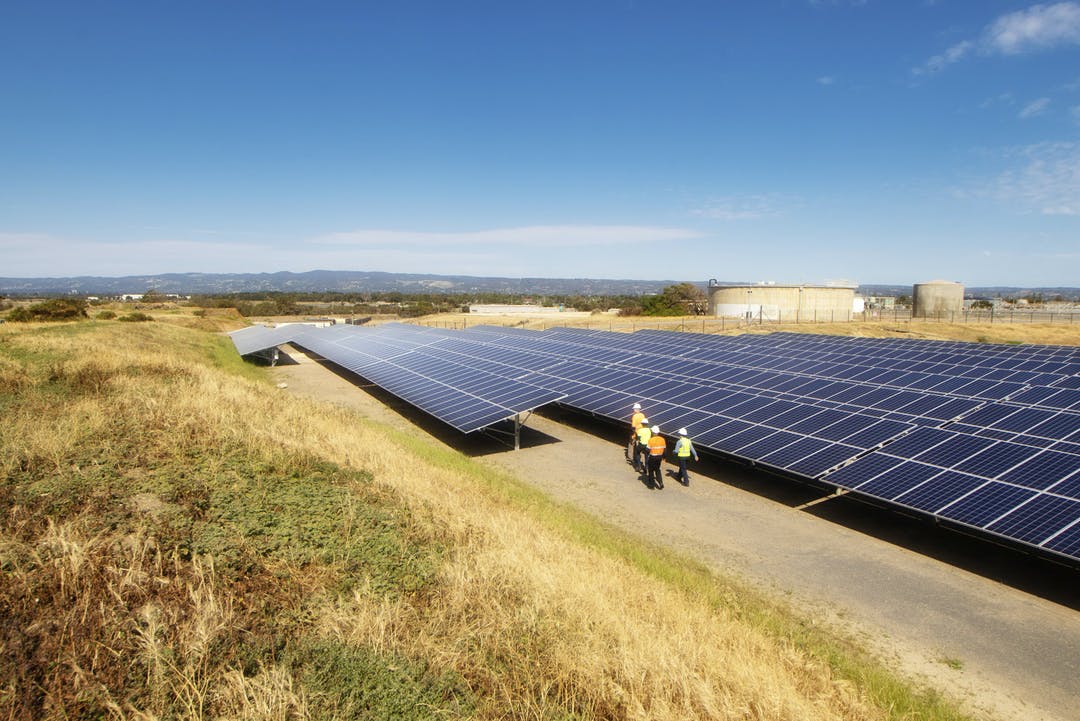In January, when South Australia’s largest water and sewage service supplier announced its plan to invest more than $300 million in solar and energy storage in 2020, one could be forgiven for thinking the dream overly ambitious. But not only has SA Water’s investment plan remained undaunted through the economic impacts of Covid-19, but continues to successfully develop its projects.
This week, SA Water began on works to install around 30,000 solar panels at Happy Valley Reservoir as part of its Zero Cost Energy Future, and also announced the completed installation of approximately 1,300 solar panels to cleanly energise the utility’s drinking water operations on the Eyre Peninsula with 770 MWh of solar energy annually. The panels are part of 500,000 panels being installed at 35 locations throughout South Australia including Port Lincoln, Kimba, Lock, Arno Bay, and Caralue Bluff.
To provide some perspective, in a particularly dry 2018/2019 SA Water’s intensive drinking water and wastewater pumping and treatment operations cost the utility $83 million on its electricity bill. SA Water’s solar investment will make sure that figure is significantly reduced in future.
Happy Valley
Unlike the characters in Patrick White’s first novel, Happy Valley, where there “never was co-operation,” the inhabitants of non-fictional Happy Valley in South Australia are a pretty happy and cooperative bunch. SA Water kept close engagement with local residents throughout the design process of the 30,000 panel solar array on Happy Valley Reservoir, ensuring the the visual beauty of the popular recreational area is not going to be disturbed.
“The solar array was reconfigured to fit in a smaller area and a 40-metre buffer of pine trees was retained between the panels…” said SA Minister for Environment and Water David Speirs. “This is a fantastic result which still enables SA Water to achieve its energy management target as well as preserve and enhance the surrounding natural environment.”
The 12 MW installation is expected to see completion early in 2021, at which point it will begin to supply clean solar electricity for the treatment and transportation of water from the Happy Valley Reservoir which provides more than 40% of metropolitan Adelaide’s drinking water.
White described Happy Valley as his “best forgotten novel,” but it cannot be said SA Water has forgotten the people of Happy Valley and South Australia.
Eyre Peninsula
The solar array is now catching the Eyre Peninsula’s winter sun and generating electricity for SA Water’s storage tanks, pump stations, and Port Lincoln depot. SA Water’s Senior Manager Zero Cost Energy Future, Nicola Murphy, said that despite Covid-19, “we’ve been able to complete our EP solar sites because we had the solar panels ready to go, and followed the guidelines for the delivery of construction programs.”
“It’s a great outcome,” continued Murphy, “which has kept our contracting partners and suppliers in jobs working on large-scale projects that have flow-on benefits to the South Australian economy while supporting local Eyre Peninsula businesses.”
Fortune Favours the Bold
Despite the unprecedented pressure from the pandemic on SA Water’s green development projects, the utility is already proposing seven more solar farms. The Essential Services Commission of South Australia (ESCOSA) has received two applications from SA Water to vary its electricity generation licence to authorise the operation of:
- a 3.675MW solar generating plant at Glenelg
- a 19.24MW solar generating plant at Bolivar
- a 15.5MW solar generating plant at the Adelaide Desalination Plant
- a 5.5MW solar generating plant at Morgan Whyalla 1
- a 5.5MW solar generating plant at Morgan Whyalla 2
- a 7.5MW solar generating plant at Morgan Whyalla 3, and
- a 5.5MW solar generating plant at Morgan Whyalla 4.
Not only is SA Water undaunted by economic pressure, but clearly its solar developments have empowered the utility in the way only renewable energy can.
This content is protected by copyright and may not be reused. If you want to cooperate with us and would like to reuse some of our content, please contact: editors@pv-magazine.com.









By submitting this form you agree to pv magazine using your data for the purposes of publishing your comment.
Your personal data will only be disclosed or otherwise transmitted to third parties for the purposes of spam filtering or if this is necessary for technical maintenance of the website. Any other transfer to third parties will not take place unless this is justified on the basis of applicable data protection regulations or if pv magazine is legally obliged to do so.
You may revoke this consent at any time with effect for the future, in which case your personal data will be deleted immediately. Otherwise, your data will be deleted if pv magazine has processed your request or the purpose of data storage is fulfilled.
Further information on data privacy can be found in our Data Protection Policy.